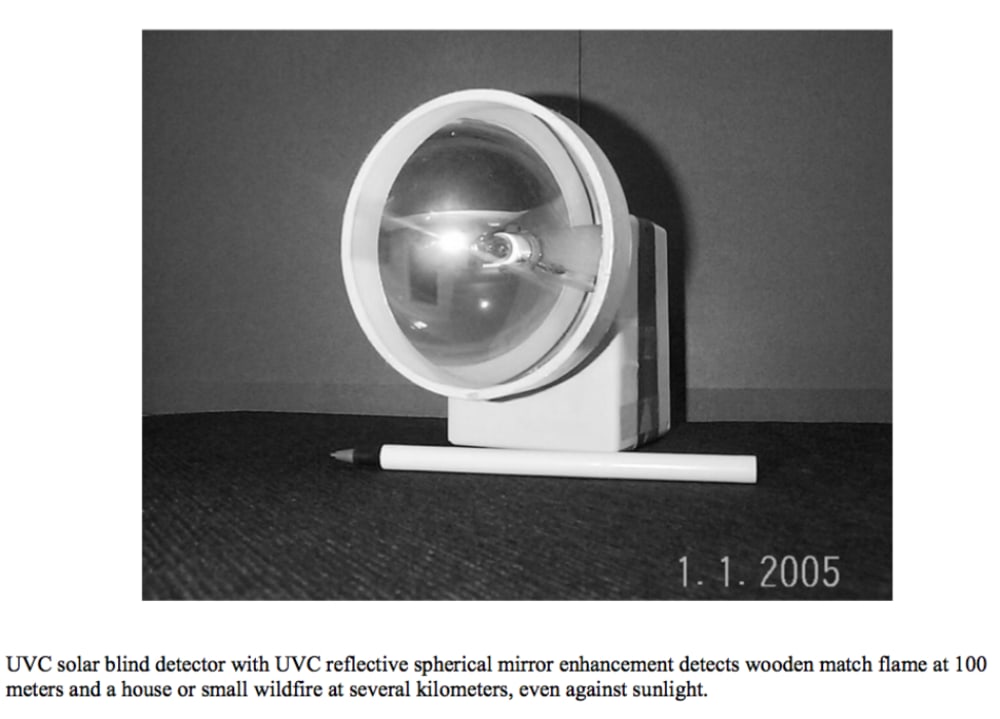LONG RANGE FIRE DETECTION AND RESPONSE
WITH UNIQUE OPTICAL DETECTOR
Approximately five billion dollars in US revenue is lost annually due to open area fires. Millions of acres of forest, many buildings and other properties are destroyed. Tragically, many brave firefighters and countless wildlife are lost. Worldwide the numbers are staggering and add additional carbon loading in the atmosphere beyond all the fossil fuel burned. Early detection of open area fires is typically performed by manned observatories, random reporting, space and aerial surveillance. These methods, while valuable, lead to unnecessarily long reporting times, low coverage, and rapid spread of wildfires. Optical flame detectors exist but typically experience high false alarms and low flame detection sensitivity in open areas due to lack of large collector area, interference from solar and man made light, and other causes. These optical flame detectors typically detect a one square meter fuel flame at only a few tens of meters.
An innovative patented (US 7,541,938) dramatic improvement permits detection of a kitchen match at about 100 meters and a small, one square meter fire at a kilometer or more, against direct sunlight. A forest or house fire can be detected several kilometers away. The use of available digital transponders allows coding multiple detectors and daisy-chaining the information, providing near instantaneous detection, location and response without GPS since the code identifies the detector. The forestry department has access to multiple emergency frequency bands for this use. A large market must exist for this technology.
This low cost innovation utilizes a cylindrical Geiger Mueller ultra-violet C (UVC) detector mounted axially in a non-imaging, electroplated or plastic spherical collector. This collector is easily constructed using a nickel phosphorus coating to reflect UVC short wavelength light obtained from decay (outer orbital electrons collapsing) in flaming materials including wood. This arrangement permits reduced heating of the detector in direct sunlight due to axial spreading of the non-focused and out-of-band IR energy. A unique distinct advantage is obtained by the fact that off-axis, the focal point moves axially, moving a focal “ring” along the length of the cylindrical detector. Alternate low cost easily manufactured, related designs are available. Although flat Geiger Mueller detectors are available, the use of conventional optics, leads to poor performance because of the minimal enclosed gas discharge working distances, local overheating by the sun and limited off-axis response. Other optical designs suitable for use of collectors, such as long wavelength infra-red detectors, typically require expensive band-pass filters and often, cryogenic cooling not easily provided in remote areas, due to size and energy requirements. The present invention uses very little energy and can be powered by solar cells plus batteries or other known means.
This technology should be implemented as soon as possible to save our firefighters and natural resources. Existing technology permits exchange of 6 billion stock shares daily and yet immediate detection of only a handful of wildfires. This technology will greatly enhance existing fire reporting capabilities.
Like this entry?
-
About the Entrant
- Name:Darell Engelhaupt
- Type of entry:individual
- Hardware used for this entry:Spectroscopy, Electroforming, Electronic TestingSoftware used for this entry:Microsoft Excel, OSLO, MathCad
- Patent status:patented

